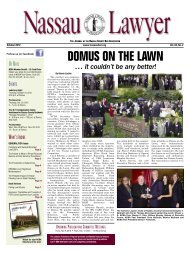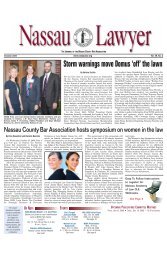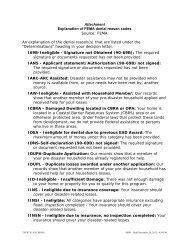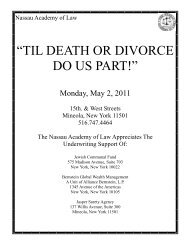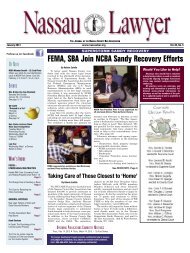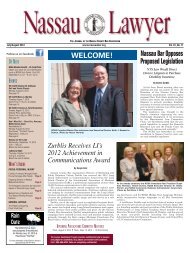443 F.3d 180 Page 3443 F.3d 180(Cite as: 443 F.3d 180)Movants-Defendants-Appellees David Mack, theEstate <strong>of</strong> Leo V. Berger, Apex Marine Corp., HarveySchwartz, Phyllis Sepe and Sigmund Kassap, Trustee<strong>of</strong> the Leo V. Berger Grantor Trust No. 1 as PersonalRepresentative <strong>of</strong> the Estate <strong>of</strong> Leo V. Berger.CARDAMONE, CABRANES, and POOLER, CircuitJudges.POOLER, Circuit Judge.Three appeals have been consolidated in this case.On July 3, 1985, plaintiffs-appellants ("plaintiffs")commenced a federal *183 action, against BriggsLeasing Corporation ("Briggs"), Briggs AcquisitionCorporation ("BAC"), and individual defendants, inwhich plaintiffs asserted individual, class, and derivativeclaims for "equitable and other relief." On March17, 1994, the United States District Court for theEastern District <strong>of</strong> New York (Johnson, J.), entered adefault judgment against Briggs. A trial against defendantRobert Rosenstock and an inquest to fixdamages against Briggs were scheduled to begin inAugust 1997. On July 31, 1997, plaintiffs and RobertRosenstock entered into a stipulation <strong>of</strong> settlementagainst Briggs and Robert Rosenstock. On August 5,1997, the United States District Court for the EasternDistrict <strong>of</strong> New York (Trager, J.) approved the stipulationby order and directed the clerk to enter a finaljudgment, which the clerk did against Briggs on August15, 1997.In 2002, plaintiffs brought fraudulent conveyanceactions in the United States District Court for theSouthern District <strong>of</strong> New York, against non-partymovants-defendants-appellees ("movants"), underNew York Debtor and Creditor <strong>Law</strong>s ("DCL"),predicated upon the August 15, 1997, judgmentagainst Briggs. In late 2002, movants initiated proceedingsto vacate plaintiffs' judgment against Briggsunder Rules 60(b)(4) and 60(b)(6) <strong>of</strong> the FederalRules <strong>of</strong> Civil Procedure.The district court (Trager, J.) granted movants' motionto vacate. Grace v. Rosenstock, No. 85-cv-2039(E.D.N.Y. Oct. 4, 2004). The district court also dismissedthe fraudulent conveyance actions, becausewithout an uncollected judgment as a predicate, therecould be no cause <strong>of</strong> action for fraudulent conveyances.Grace v. Bank Leumi, No. 04-cv-0708(E.D.N.Y. Oct. 6, 2004); Grace v. Schwartz, No. 04-cv-1622 (E.D.N.Y. Oct. 14, 2004).We affirm.BackgroundPrior to 1985, Briggs was a publicly-held autoleasingcompany incorporated in New York. RobertRosenstock, his father Edward Rosenstock, andRobert Genser ("Genser") were <strong>of</strong>ficers and directors<strong>of</strong> Briggs and owned, respectively, approximately 64percent, 3 percent, and 5 percent <strong>of</strong> its outstandingstock. In January 1985, Robert Rosenstock and Genserdecided to take Briggs private in a freeze-outmerger. [FN1] They incorporated BAC and plannedto merge BAC and Briggs, buy out Briggs's minorityshareholders, and make Briggs the surviving corporation.Rosenstock and Genser contributed all <strong>of</strong> theirBriggs shares to BAC. Rosenstock purchased hisfather's shares <strong>of</strong> Briggs stock and contributed themto BAC. As a result, BAC owned 72 percent <strong>of</strong> thestock <strong>of</strong> Briggs, with Rosenstock and Genser owningall <strong>of</strong> the stock <strong>of</strong> BAC.FN1. Under New York's Business Corporation<strong>Law</strong> ("BCL"), a merger may be authorizedby the affirmative vote <strong>of</strong> two-thirds <strong>of</strong>the corporation's shares. See N.Y. BCL §903(a)(2) (McKinney 2006).Briggs outlined a plan for a merger with BAC in aJanuary 1985 proxy statement to its shareholders. Allshareholders would be bought out at $1.50 per share.Eighty-six percent <strong>of</strong> the minority shareholders, includingnamed plaintiffs, filed notices <strong>of</strong> election todissent. A February 1985 special meeting approvedthe merger based solely on BAC's vote. At the meeting,plaintiffs voted their shares against the merger.The merger was nevertheless consummated on February26, 1985, when Rosenstock and Genser becamethe sole holders <strong>of</strong> Briggs shares, owning approximately93 percent and 7 percent, respectively.*184 On May 20, 1985, plaintiffs brought an appraisalaction against Briggs in the Supreme Court <strong>of</strong>the State <strong>of</strong> New York, <strong>Nassau</strong> County, to fix the fairvalue <strong>of</strong> their shares as dissenting shareholders.[FN2] Briggs answered this action through counselon July 23, 1985. Plaintiffs also notified the statecourt <strong>of</strong> their intention to file a federal action andrequested that their appraisal action be held in abeyancepending the final determination <strong>of</strong> their case in© 2009 Thomson Reuters. No Claim to Orig. US Gov. Works.
443 F.3d 180 Page 4443 F.3d 180(Cite as: 443 F.3d 180)federal court. The state court did so on October 7,1985. Plaintiffs then commenced a federal action,asserting individual, class, and derivative claims for"equitable and other relief," in an amended complaintdated July 1, 1985. They named Robert Rosenstock,Genser, Edward Rosenstock, Briggs, and BAC asdefendants. They alleged, inter alia, violations <strong>of</strong> theSecurities Exchange Act <strong>of</strong> 1934, the New YorkBusiness Corporation <strong>Law</strong> ("BCL"), and fiduciaryduties. They also brought derivative actions on behalf<strong>of</strong> Briggs against Robert Rosenstock, Genser, andEdward Rosenstock, for allegedly using corporatefunds for personal expenses and diverting corporateopportunities to competing companies they owned.They requested that the class action be certified, themerger be set aside, the terms <strong>of</strong> the merger be reformed,the defendants "account for the damagessuffered by Briggs and the pr<strong>of</strong>its and benefits enjoyedby the individual defendants by reason <strong>of</strong> [theirwrongful conduct]," and the court give "such other,further, and different relief as may be just, includingdamages, together with costs, disbursements and areasonable fee for plaintiffs' attorneys." DefendantsRobert Rosenstock, Genser, and Edward Rosenstockanswered this complaint on July 22, 1985, and Briggsanswered separately, also on July 22, 1985. Briggsand the individual defendants were represented bydifferent attorneys.FN2. This action was brought under NewYork's BCL. See N.Y. BCL § 623(h)(1)(McKinney 2006). The named plaintiffsowned approximately 1.25 percent <strong>of</strong> Briggsstock prior to the merger, and the classowned about 14 percent, roughly equivalentto 83,402 shares.In an August 14, 1986, memorandum and order, thedistrict court (Costantino, J.) granted plaintiffs' motionfor class certification. Grace v. Rosenstock, No.cv-85-2039 (E.D.N.Y. Aug. 14, 1986) ("Grace I").[FN3] In January 1988, Finley, Kumble, Wagner,Heine, Underberg, Manley & Casey ("Finley Kumble"),the law firm that represented Briggs, declaredbankruptcy, leaving Briggs without legal representation.Michael Rosen, the attorney for the individualdefendants, determined that Briggs and his clientshad a conflict <strong>of</strong> interest, and he could therefore notrepresent Briggs. Briggs did not appear by counselfor the next five years. Meanwhile, on January 19,1989, an order <strong>of</strong> discontinuance was entered by theUnited States District Court for the Eastern District<strong>of</strong> New York (Costantino, J.), because the court receiveda report stating that the action had been settled.Grace v. Rosenstock, No. 85-cv-2039 (E.D.N.Y.Jan. 19, 1989) ("Grace II"). In fact, Halperin v.Rosenstock, No. 85-cv-1258, an action brought byRobert Rosenstock's sister and brother-in-law (alsoBriggs minority shareholders), had settled. This settlementinadvertently led Judge Costantino to closeGrace I.FN3. Because <strong>of</strong> the long and complex proceduralhistory in this case, each <strong>of</strong> the federalcourt decisions has been assigned, inchronological order, a roman numeral forthe purposes <strong>of</strong> this opinion. For ease <strong>of</strong> referencewe attach an appendix identifyingGrace I through XIII.Four years later, on March 1, 1993, plaintiffs movedto set aside the order <strong>of</strong> discontinuance and reopenGrace I. On *185 March 24, 1993, an order from theUnited States District Court for the Eastern District<strong>of</strong> New York (Raggi, J.) held that Grace I had beenclosed in error and reopened it. Grace v. Rosenstock,No. cv-85-2354 (E.D.N.Y. Mar. 29, 1993) ("GraceIII"). Plaintiffs then moved for a default judgmentagainst Briggs and BAC on the issue <strong>of</strong> liability, andfor an inquest after discovery to determine theamount <strong>of</strong> damages to be included in the judgment.Michael Rosen filed a motion to withdraw as counselfor defendants in June 1993. Genser obtained newcounsel. Briggs and Rosenstock did not obtain newcounsel. In 1993, pursuant to Rule 55 <strong>of</strong> the FederalRules <strong>of</strong> Civil Procedure, default judgments wereentered against Briggs and BAC, as neither corporationwas represented by counsel. Grace v. Rosenstock,No. 85-cv-2039 (E.D.N.Y. June 8, 1993)("Grace IV").Almost two-and-one-half years later, in January1996, plaintiffs moved for leave to amend the complaint,which had been filed nearly nine years earlier,to assert additional claims against the defendants andadd additional defendants, including non-partymovants. Plaintiffs wanted to set aside as void theallegedly fraudulent transfers to Bank Leumi, DavidMack, Leo V. Berger, and Apex Marine Corporation.Plaintiffs alleged that Briggs executed promissorynotes and mortgages on real property in favor <strong>of</strong> Bergerand Mack, in exchange for loans. Neither party© 2009 Thomson Reuters. No Claim to Orig. US Gov. Works.
- Page 1 and 2:
Nassau Academy of LawCLE Live Class
- Page 3 and 4:
McKinney's Debtor and Creditor Law
- Page 5 and 6:
McKinney's Debtor and Creditor Law
- Page 7 and 8:
McKinney's Debtor and Creditor Law
- Page 9 and 10:
McKinney's Debtor and Creditor Law
- Page 11 and 12:
McKinney's Debtor and Creditor Law
- Page 13 and 14:
McKinney's Debtor and Creditor Law
- Page 15 and 16:
McKinney's Debtor and Creditor Law
- Page 17 and 18:
McKinney's Debtor and Creditor Law
- Page 19 and 20:
BAKER & HOSTETLER LLP45 Rockefeller
- Page 21 and 22:
usiness of defendant Bernard L. Mad
- Page 23 and 24:
BACKGROUND, THE TRUSTEE, AND STANDI
- Page 25 and 26:
Madoff who received fraudulent tran
- Page 27 and 28:
ased on fictitious profits and for
- Page 29 and 30:
28. BLMIS funds were also used to p
- Page 31 and 32:
Madoff, and her niece, Shana Madoff
- Page 33 and 34:
42. Ruth Madoff was never an employ
- Page 35 and 36:
FIRST CAUSE OF ACTIONTURNOVER AND A
- Page 37 and 38:
66. At the time of each of the Two-
- Page 39 and 40:
Transfers; (b) directing that the S
- Page 41 and 42:
EIGHTH CAUSE OF ACTIONUNDISCOVERED
- Page 43 and 44:
TENTH CAUSE OF ACTIONDISALLOWANCE O
- Page 45 and 46:
111. Mrs. Madoff benefited from the
- Page 47 and 48:
WHEREFORE, the Trustee respectfully
- Page 49 and 50:
2(c)(3): (a) preserving the Subsequ
- Page 51 and 52:
302 B.R. 760 Page 1302 B.R. 760(Cit
- Page 53 and 54:
302 B.R. 760 Page 3302 B.R. 760(Cit
- Page 55 and 56:
302 B.R. 760 Page 5302 B.R. 760(Cit
- Page 57 and 58: 302 B.R. 760 Page 7302 B.R. 760(Cit
- Page 59 and 60: 302 B.R. 760 Page 9302 B.R. 760(Cit
- Page 61 and 62: 302 B.R. 760 Page 11302 B.R. 760(Ci
- Page 63 and 64: 302 B.R. 760 Page 13302 B.R. 760(Ci
- Page 65 and 66: 302 B.R. 760 Page 15302 B.R. 760(Ci
- Page 67 and 68: 302 B.R. 760 Page 17302 B.R. 760(Ci
- Page 69 and 70: 302 B.R. 760 Page 19302 B.R. 760(Ci
- Page 71 and 72: 394 B.R. 721 Page 1394 B.R. 721, 50
- Page 73 and 74: 394 B.R. 721 Page 3394 B.R. 721, 50
- Page 75 and 76: 394 B.R. 721 Page 5394 B.R. 721, 50
- Page 77 and 78: 394 B.R. 721 Page 7394 B.R. 721, 50
- Page 79 and 80: 394 B.R. 721 Page 9394 B.R. 721, 50
- Page 81 and 82: 394 B.R. 721 Page 11394 B.R. 721, 5
- Page 83 and 84: 394 B.R. 721 Page 13394 B.R. 721, 5
- Page 85 and 86: 394 B.R. 721 Page 15394 B.R. 721, 5
- Page 87 and 88: 394 B.R. 721 Page 17394 B.R. 721, 5
- Page 89 and 90: 394 B.R. 721 Page 19394 B.R. 721, 5
- Page 91 and 92: 394 B.R. 721 Page 21394 B.R. 721, 5
- Page 93 and 94: 397 B.R. 642 Page 2397 B.R. 642(Cit
- Page 95 and 96: 397 B.R. 642 Page 4397 B.R. 642(Cit
- Page 97 and 98: 397 B.R. 642 Page 6397 B.R. 642(Cit
- Page 99 and 100: 397 B.R. 642 Page 8397 B.R. 642(Cit
- Page 101 and 102: 397 B.R. 642 Page 10397 B.R. 642(Ci
- Page 103 and 104: 397 B.R. 642 Page 12397 B.R. 642(Ci
- Page 105 and 106: 397 B.R. 642 Page 14397 B.R. 642(Ci
- Page 107: 443 F.3d 180 Page 2443 F.3d 180(Cit
- Page 111 and 112: 443 F.3d 180 Page 6443 F.3d 180(Cit
- Page 113 and 114: 443 F.3d 180 Page 8443 F.3d 180(Cit
- Page 115 and 116: 443 F.3d 180 Page 10443 F.3d 180(Ci
- Page 117 and 118: 443 F.3d 180 Page 12443 F.3d 180(Ci
- Page 119 and 120: Page 2257 A.D.2d 526, 684 N.Y.S.2d
- Page 121 and 122: Page 4257 A.D.2d 526, 684 N.Y.S.2d
- Page 123 and 124: Page 6257 A.D.2d 526, 684 N.Y.S.2d
- Page 125 and 126: 770 N.Y.S.2d 421 Page 22 A.D.3d 780
- Page 127 and 128: Page 14 A.D.3d 495, 773 N.Y.S.2d 71
- Page 129: Page 34 A.D.3d 495, 773 N.Y.S.2d 71
- Page 132 and 133: 780 N.Y.S.2d 409 Page 29 A.D.3d 553
- Page 134 and 135: Page 134 A.D.3d 231, 824 N.Y.S.2d 3
- Page 136 and 137: Page 334 A.D.3d 231, 824 N.Y.S.2d 3
- Page 138 and 139: Page 2991 F.2d 31(Cite as: 991 F.2d
- Page 140 and 141: Page 4991 F.2d 31(Cite as: 991 F.2d
- Page 142 and 143: Page 6991 F.2d 31(Cite as: 991 F.2d
- Page 144 and 145: FRAUDULENT TRANFERENCESRonald M. Te
- Page 146 and 147: Nursing home case_ Transfer of pers
- Page 148 and 149: Sections 548 and 544 work in concer
- Page 150 and 151: U.S. Supreme CourtBFP v. Resolution
- Page 152 and 153: example, from net 15 to COD; or cha
- Page 154 and 155: Bankruptcy Code Section§ 548. Frau
- Page 156: Ron Terenzi is a founding partner a



